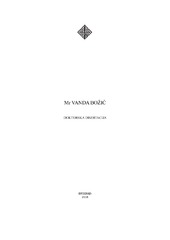Gluma u dramskom i gluma u postdramskom teatru
Metadata
Show full item recordAuthor:
Božić, VandaFaculty:
Факултет драмских уметностиDate Issued:
27-09-2018Advisor:
Romčević, dr NebojšaCommittee members:
- Medenica, dr Ivan
- Rapajić, Svetozar
- Milivojević Mađarev, Marina
- Ilić, dr Vlatko
Abstract
Predmet rada odnosi se na glumu u dramskom i glumu u postdramskom teatru, sa
svrhom da istraži sličnosti i/ili razlike među njima. Gluma u dramskom teatru predstavlja
oponašanje stvarne radnje gdje je glumac dramski lik koji želi provesti neku svoju volju, postići
neki svoj cilj. Njemu se suprostavlja drugi dramski lik iz čega nastaje dramski sukob. U
dramskom teatru prevladavaju većinom verbalni znakovi temeljeni na dijalogu i monologu.
Glumac u epskom teatru se distancira od lika kojeg igra, on se s njim ne poistovjećuje, kao što
to čini glumac u dramskom teatru. Glumac u epskom teatru svoj lik pokazuje.
S druge strane, postdramski teatar negira načelo mimetizma, izbjegava oponašanje i
podražavanje, on uglavnom operira s neverbalnim znakovima, paralingvističkim i
ekstralingvističkim. Pojam smrti karaktera koji se veže uz postdramski teatar ne može biti
definiran na takav način, jer se tu u suštini ne radi o smrti karaktera, već o drugačijem
označavanju s obzirom da se u po...stdramskom teatru događa jedna kompleksna preobrazba u
samoj prirodi karaktera. Glumac je u dramskom teatru označen kao glumac, dok je u
postdramskom teatru za glumca primjereniji naziv izvođač. Razlika između glume u dramskom
i postdramskom teatru očituje se u različitom (drugačijem) korištenom sustavu svih kazališnih
znakova.
Za potrebe ovog rada provedene su tri strukture istraživanja. Prvo istraživanje obuhvaća
analizu predstave Petera Handkea “Psovanje publike” u kojoj Handke u biti piše jedan esej o
pitanjima dramskog, epskog i postdramskog teatra, a koji označava kraj avangarde i onoga što
će se zvati postmoderna te već u tom tekstu ispituje sve elemente koji su prisutni u raspravi o
dramskom i postdramskom. Drugo istraživanje odnosi se na profesionalne glumce, redatelje i
teatrologe o pitanjima glume u dramskom i postdramskom teatru, kako bi se sa profesionalnog
stanovišta dobio uvid u njihovo poimanje distinkcije i/ili sličnosti između glume u dramskom i
postdramskom teatru. I treće istraživanje provedeno je među gledateljima kazališnih predstava,
kako bi se dobili odgovori na pitanja kako publika i na koji način percipira i doživljava dramsku
i postdramsku predstavu te što za njih znači gluma u dramskom, a što u postdramskom teatru;
sve s ciljem da ovaj rad dobije objektivan i sveobuhvatan karakter.
Na osnovu postavljenog teorijskog okvira i provedenih istraživanja, u zaključnim
razmatranjima potvrđene su postavljenje hipoteze rada da postdramski teatar označava
izvođačko-umjetničku formu koja se nadovezuje na dramski teatar i koja je na kraju i proizašla
iz dramskog teatra. Međutim, u postdramskom teatru koriste se različiti jezični sistemi i
različite tehnike označavanja. Kazališni znak u postdramskom teatru ostaje, on je i dalje znak,
ali je njegova funkcija promijenjena. Do toga dolazi iz razloga što se glumačka sredstva
povećavaju pa tako i gluma doživljava stalnu transformaciju i evoluciju
The paper deals with acting in drama and postdramatic theater, with the purpose of
exploring similarities and/or differences between them. Acting in the drama theater represents
the imitation of real action where the actor is a drama character who wants to impose some of
his will, to achieve some of his goals. He is opposed by another drama character from which a
dramatic conflict arises. Drama theater is mostly dominated by verbal signs based on dialogue
and monologue. The actor in the epic theater is distanced from the character he plays, he does
not identify with him, as does an actor in the drama theater. An actor in an epic theater shows
his character.
On the other hand, the post-drama theater negates the principle of mimetism, avoids
imitation and excitement, it mostly operates with non-verbal signs, paralingvistic and
extralinguistic. The concept of the death of a character that is connected to the postdramatic
theater can not be defined in such a way, since it is ess...entially not about the death of a character,
but about a different marking since in the postdramatic theater a complex transformation takes
place in the very nature of the character. The actor is in the drama theater marked as an actor,
while in the post-drama theater performer is a more appropriate name for the actor. The
difference between acting in the drama and postdramatic theater is manifested in the different
system used for all the theatrical signs.
For this paper, three research structures have been implemented. The first research
involves the analysis of Peter Handke's "Offending the Audience", in which Handke essentially
writes an essay on the issues of the drama, epic and postdramatic theater, which marks the end
of avant-garde and what will be called postmodern, and examines all elements that are present
in the debate on dramatic and postdramatic. The second study deals with professional actors,
directors and theaters on issues of acting in the drama and postdramatic theaters in order to gain
a professional view of their understanding of the distinction and/or similarity between acting in
the drama and post-drama theater. And the third survey was conducted among the audience of
theater performances in order to get answers to how and which way does the audience perceive
and experience the dramatic and postdramatic performance and what does the acting dramatic
and postdramatic theater mean for them; all with the aim of giving this work an objective and
comprehensive character.
Based on the established theoretical framework and the researches carried out, in the
concluding considerations the hypothesis of the postdramatic theater has been confirmed to
indicate the performer-artistic form which is complementary to the drama theater and which
eventually came from the drama theater. However, postdramatic theater uses different language
systems and different marking techniques. The theater sign in postdramatic theater remains, it
is still a sign, but its function has changed. This is due to the fact that acting means are
increasing, so the acting is experiencing constant transformation and evolution.

